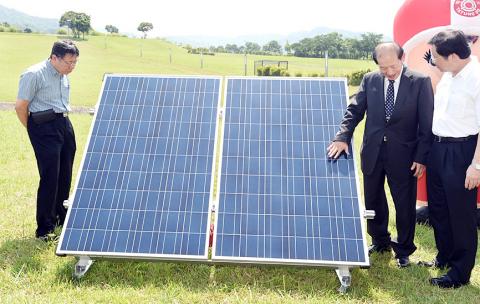Taipei is building its first solar power plant using ground-mounted solar panels at a former landfill, the city government said yesterday.
The project is part of the capital’s efforts to expand the use of renewable energy.
The Taipei Department of Environmental Protection yesterday signed a contract with Taipei-based Tatung, one of Taiwan’s leading brands for energy saving and “green” energy-related systems and services, at a ceremony at Fudekeng Environmental Restoration Park (福德坑復育公園), where the solar power plant is to be built.

Photo: Liao Chen-huei, Taipei Times
The 37 hectare park in the Muzha (木柵) area on the southeastern edge of the city used to be a landfill.
The solar power plant is expected to be completed by the end of this year and is to be able to generate up to 2 million kilowatt-hours of electricity per year, the Taipei Department of Environmental Protection said.
Speaking at the ceremony, Taipei Mayor Ko Wen-je (柯文哲) said that renewable energy sources generate about 487 million kilowatt-hours of electricity for Taipei, which accounts for only 3 percent of the city’s total power consumption.
The city is aiming to increase the contribution by renewable energy sources to 10 percent of its total power generation by the end of 2025, Ko said.
To that end, the city government is to use public land to develop solar power systems and will also subsidize the private sector to install solar power facilities to encourage wider use of solar energy, Ko said.
The new plant is expected to cut 18,905 tonnes of carbon emissions in the city annually, the department said.
The park is spacious and receives sufficient sunlight, department Commissioner Liou Ming-lone (劉銘龍) said, citing the latter as one of the reasons that it was chosen as the location for the plant.

US climber Alex Honnold is to attempt to scale Taipei 101 without a rope and harness in a live Netflix special on Jan. 24, the streaming platform announced on Wednesday. Accounting for the time difference, the two-hour broadcast of Honnold’s climb, called Skyscraper Live, is to air on Jan. 23 in the US, Netflix said in a statement. Honnold, 40, was the first person ever to free solo climb the 900m El Capitan rock formation in Yosemite National Park — a feat that was recorded and later made into the 2018 documentary film Free Solo. Netflix previewed Skyscraper Live in October, after videos

NUMBERS IMBALANCE: More than 4 million Taiwanese have visited China this year, while only about half a million Chinese have visited here Beijing has yet to respond to Taiwan’s requests for negotiation over matters related to the recovery of cross-strait tourism, the Tourism Administration said yesterday. Taiwan’s tourism authority issued the statement after Chinese-language daily the China Times reported yesterday that the government’s policy of banning group tours to China does not stop Taiwanese from visiting the country. As of October, more than 4.2 million had traveled to China this year, exceeding last year. Beijing estimated the number of Taiwanese tourists in China could reach 4.5 million this year. By contrast, only 500,000 Chinese tourists are expected in Taiwan, the report said. The report

Temperatures are forecast to drop steadily as a continental cold air mass moves across Taiwan, with some areas also likely to see heavy rainfall, the Central Weather Administration (CWA) said. From today through early tomorrow, a cold air mass would keep temperatures low across central and northern Taiwan, and the eastern half of Taiwan proper, with isolated brief showers forecast along Keelung’s north coast, Taipei and New Taipei City’s mountainous areas and eastern Taiwan, it said. Lows of 11°C to 15°C are forecast in central and northern Taiwan, Yilan County, and the outlying Kinmen and Lienchiang (Matsu) counties, and 14°C to 17°C

STEERING FAILURE: The first boat of its class is experiencing teething issues as it readies for acceptance by the navy, according to a recent story about rudder failure The Hai Kun (海鯤), the nation’s first locally built submarine, allegedly suffered a total failure of stern hydraulic systems during the second round of sea acceptance trials on June 26, and sailors were forced to manually operate the X-rudder to turn the submarine and return to port, news Web site Mirror Daily reported yesterday. The report said that tugboats following the Hai Kun assisted the submarine in avoiding collisions with other ships due to the X-rudder malfunctioning. At the time of the report, the submarine had completed its trials and was scheduled to begin diving and surfacing tests in shallow areas. The X-rudder,